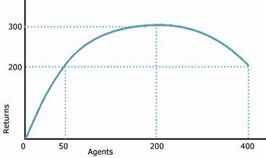
Graph Illustrating the Law of Diminishing Marginal Returns
Law of Diminishing Returns[]
- Diminishing Returns occurs in the short run when one factor is fixed (e.g. Capital).
- Definition: Diminishing Returns (also called diminishing marginal returns) refers to how the marginal production of a factor of production starts to progressively decrease as the factor is increased, in contrast to the increase that would otherwise be normally expected.This occurs when one factor of production (number of workers, for example) increases, while other factors (machines and workspace, for example) are held constant, the resulting increase in output will level-off after some time and then decline. Although the marginal productivity of the workforce will decreases as output increases, diminishing returns do not mean negative returns until (in this example) the number of workers exceeds the available machines or workspace.
example: The effectiveness of extra workers in a small café. If more workers are employed production could increase but at a decreasing rate.
- When capital is fixed extra workers will eventually get in each other’s way as they attempt to increase production.
- This law only applies in the short run because in the long run all factors are variable.
- The MC of a sandwich will be the Cost of the worker divided by the number of extra sandwiches that are produced.
Another example of Diminishing Returns relates to the use of chemical Fertilizers. A small quantity leads to a big increase in output, thus increasing its use further may lead to declining Marginal product. Why by more of it if it's purpose doesn't yield as much utility?